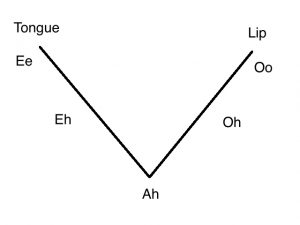Learning how to properly sing vowels is a major obstacle for beginner singers. One of the hardest vowels to sing is the Ee vowel. Why? When we were young, we were taught to “Say Cheese” before taking a photo. Saying “cheese” not only forced a huge, toothy grin, but also tensed muscles in the jaw, cheeks and lips. These muscle engagements can cause a lot of stress on the human voice when trying to produce sound. When first learning how to sing, getting away from this habit can take some time. This can be true for many vowels. For some, the Ee vowel can be easy to sing. Although producing the sound may be a simple task, the difficulty lies in maintaining space as you sing.
What’s so important about space?
Think of an instrument and the sound it makes. No matter what instrument you are thinking about, that instrument makes its signature sound because of its shape. A trumpet makes a loud brassy sound while a tuba makes a low robust sound. A cello makes a round, lower sound while a violin makes a higher, tinny sound. The shape of the instrument always determines its overall sound. The voice is the same except for one major difference: we can change the shape of our instrument at any time. This can be both good and bad. If the shape of our instrument puts strain or hinders the production of sound, we can create some bad habits or even damage our voice.
The most important skill a beginner singer can learn is how to create space. There are many different techniques you can use, but one of the easiest is generating a yawn feeling in the back of throat as you sing. This causes the larynx to drop, which allows the vocal cords to vibrate properly and producing a better sound with greater strength. It will also increase power so you don’t have to work so hard. Space coupled with a good breathing technique is half the battle on your journey to perfect technique.
A little history…
In 1886, a group of doctors and educators formed the International Phonetic Association in Paris, France. Soon after forming, the group created a system called the International Phonetic Alphabet (IPA). The IPA was created to enhance teaching worldwide to better help students with reading and learning foreign languages. Little did they know that creating this system would also help vocalists to more easily sing without creating tension in the voice.
The Tongue and Lip Chart
Within the IPA, the group created a vowel diagram, explaining how the jaws, lips and tongue form each vowel. The vowel diagram can be complicated as it includes every vowel from several different languages, so I use a simple chart called the Tongue and Lip Vowel Chart. The Tongue and Lip Vowel Chart uses the muscles that provide space, the tongue and the lip muscles to produce a controlled sound with minimal tension.

Tongue and Lip Vowel Chart
Lip Vowels
Because of the natural shape of our vocal instrument, the easiest vowel to sing with the least tension is the Ah vowel. Notice how the Ah vowel is the center of the chart. From there, in order to maintain space, we can continue singing “Ah” but change the vowel with either the lips or the tongue. Try it. Sing “Ah” and slowly bring the lips forward toward a pucker. Notice anything? If you went slowly, the vowel changed from “Ah” to “Oh” and then onto “Oo”. If you closed the lips all the way, you produced a singable “Mm” sound while still maintaining space.
Tongue Vowels
The tongue vowels are a little different and harder to control. For this exercise, put the tip of your tongue on the back of the bottom teeth and relax it. Notice how the back of the tongue doesn’t relax flat, it relaxes high and arched. This is because the bulk of the tongue muscle is in the throat. From there, it spits the tongue up and out, causing an arch in the back.
Now sing “Ah” just as you did with the lip vowels. While maintaining the “Ah” sound, slowly lift the back of the tongue towards the roof of the mouth. To do this, keep the tip of the tongue on the back of the bottom teeth and lightly push forward. By doing this slowly, you should hear an “Eh” vowel and finally an “Ee” vowel. If the tongue touched the roof of your mouth, you probably produced either a “Nn” or “Ng” sound. The good thing about these exercises is that you maintained space and produced vowels with minimal tension.
Try it for yourself
At first, it can be very difficult and awkward, almost like having a fat tongue. After some practice, you’ll notice how easily you can make an Ee vowel without the kind of tension produced when you say “Cheese.” For a good tongue workout, try singing “Ee-Ah” on a descending 5544332211 scale. Keep the tip of the tongue glued to the bottom teeth and try not to move your jaw. Remember to form “Ah” the entire time, allowing only the tongue to change the vowel to “Ee.” When done properly, only the tongue should move. Creating this and any other vowel by using only the tongue or lips, will take unnecessary tension away from your voice, enabling you to produce a powerful sound with less work.
©2018 SeanyMac Studios, Sean Oliver All rights reserved.
